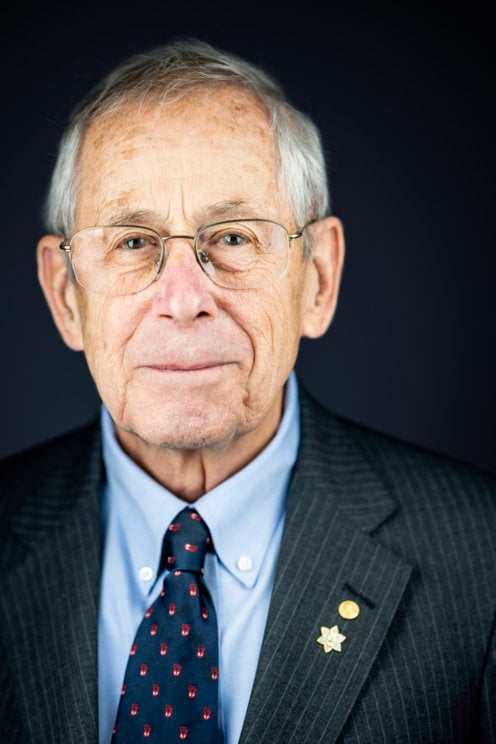Jim Peebles Biography And Wiki
Jim Peebles is a Canadian-American astrophysicist, space expert, and hypothetical cosmologist who is right now the Albert Einstein Professor Emeritus of Science at Princeton University. He is generally viewed as one of the world’s driving hypothetical cosmologists in the period since 1970, with major hypothetical commitments to primordial nucleosynthesis, dim issue, the astronomical microwave foundation, and structure arrangement.
Jim Peebles Age And Birthday
Phillip James Edwin Peebles OM FRS was born in St. Boniface in Winnipeg, Manitoba, Canada, on April 25, 1935. He is a Canadian-American astrophysicist, astronomer, and theoretical cosmologist who is currently the Albert Einstein Professor Emeritus of Science at Princeton University.
He is 84 years as of 2019. He celebrates his birthday on the 25th of April every year. He will be turning 85 years old on 25 April 2020.
Jim Peebles Height And Weight
Peebles appears to be quite tall in stature if his photos, relative to his surroundings, are anything to go by. However, details regarding his actual height and other body measurements are currently not publicly available. We are keeping tabs and will update this information once it is out.

Jim Peebles Education
Jim Peebles was born in Winnipeg, Manitoba, Canada. He completed his bachelor’s degree at the University of Manitoba. He left Manitoba in the fall of 1958 to attend Princeton University, where he completed his doctorate supervised by Robert Dicke; he remained at Princeton for his whole career.
Jim Peebles Family, Parents And Siblings
Talking about his family background, He was born in St. Boniface in Winnipeg, Manitoba, Canada, on April 25, 1935, and completed his bachelor’s degree at the University of Manitoba.
He left Manitoba in the fall of 1958 to attend Princeton University, where he completed his doctorate supervised by Robert Dicke; he remained at Princeton for his whole career. Peebles was a Member in the School of Natural Sciences at the Institute for Advanced Study in the academic year 1977–78; he made subsequent visits in 1990–91 and 1998–99.
Jim Peebles Wife, Spouse, Married
Jim likes to keep his personal life private hence information about his dating life is not available. It is therefore not known whether he is married or has any children. However, this information will be updated as soon as it is available.
Jim Peebles Astronomer, Physical Cosmology, The Big Bang Theory, Quantum Mechanics
Peebles has made many important contributions to the Big Bang model. With Dicke and others (nearly two decades after George Gamov, Ralph A. Alpher, and Robert C. Herman), Peebles predicted the cosmic microwave background radiation. Along with making major contributions to Big Bang nucleosynthesis, dark matter, and dark energy, he was the leading pioneer in the theory of cosmic structure formation in the 1970s.
Long before it was considered a serious, quantitative branch of physics, Peebles was studying physical cosmology and has done much to establish its respectability. His Shaw Prize citation states “He laid the foundations for almost all modern investigations in cosmology, both theoretical and observational, transforming a highly speculative field into a precision science.”
Peebles has a long record of innovating the basic ideas, which would be extensively studied later by other scientists. For instance, in 1987, he proposed the primordial isocurvature baryon model for the development of the early universe. Similarly, Peebles contributed to establishing the problem of dark matter in the early 1970s. Peebles is also known for the Ostriker–Peebles criterion, relating to the stability of galactic formation.
His three textbooks (Physical Cosmology, 1971; Large Scale Structure of the Universe, 1980; Principles of Physical Cosmology, 1993) have been standard references in the field. In Principles of Physical Cosmology, he expressed a preferred reference frame for velocity anywhere in the universe based on Isotropic Cosmic Background Radiation, a departure from previous models[opinion], but according to Peebles not in violation of Relativity. Victor Weisskopf gave the same opinion in his book.
Without compromising Relativity principles in 1949 Albert Einstein introduced the concept of a preferred inertial frame in his Autobiographical Notes with the recommendation that kinetic energy should be developed as a field concept[dubious – discuss], but this was not possible at the time before the discovery of Cosmic Background Radiation. He was awarded the 2019 Nobel prize for physics.
Jim Peebles Physics
Jim Peebles Nobel laureates in physics
James Peebles, Michel Mayor, and Didier Queloz are the 2019 Nobel laureates in physics. The three scientists were awarded the 2019 Nobel prize in physics for groundbreaking discoveries about the evolution of the Universe and the Earth’s place within it. The Canadian scientist James Peebles has been awarded half of the 9m Swedish kronor (£740,000) prize for his theoretical discoveries about the evolution of the universe.
A Swiss duo of astronomers, Michel Mayor and Didier Queloz, will share the other half of the prize for their discovery of the first planet beyond our solar system. James Peebles was rewarded for laying a foundation for modern cosmology, including his realization that the faint microwave radiation that fills the cosmos contains crucial clues to how the universe evolved after the Big Bang and the development of a radical theory on the nature of dark matter.
Jim Peebles Book
His three textbooks (Physical Cosmology, 1971; Large Scale Structure of the Universe, 1980; Principles of Physical Cosmology, 1993) have been standard references in the field.
In Principles of Physical Cosmology, he expressed a preferred reference frame for velocity anywhere in the universe based on Isotropic Cosmic Background Radiation, a departure from previous models, but according to Peebles not in violation of Relativity.
Victor Weisskopf gave the same opinion in his book. Without compromising Relativity principles in 1949 Albert Einstein introduced the concept of a preferred inertial frame in his Autobiographical Notes with the recommendation that kinetic energy should be developed as a field concept, but this was not possible at the time before the discovery of Cosmic Background Radiation.
Jim Peebles Net Worth
Information concerning his net worth is still under research and will soon be updated immediately we come across details concerning his net worth.
Jim Peebles Nobel Prize
Peebles was granted a portion of the Nobel Prize in Physics in 2019 for his hypothetical revelations in physical cosmology. He imparted the prize to Michel Mayor and Didier Queloz for their disclosure of an exoplanet circling a sun-like star.
Nobel Prize in Physics: James Peebles, master of the universe, shares award
During the press conference in which he was revealed as one of the winners of the 2019 Nobel Prize in Physics, James (Jim) Peebles was asked to point to a single discovery or breakthrough from his long career that would put the award in context. Peebles demurred, replying instead: “It’s a life’s work.”
That’s a perfect description of his contribution to our understanding of the universe. His is a career so influential that he is widely recognized as one of the key architects of the field of physical cosmology, the study of the universe’s origin, structure and evolution. I am sure I am not alone in regarding Peebles as the greatest living cosmologist.
Peebles’s research career started in the early 1960s. The Canadian-born scientist earned his undergrad at the University of Manitoba and later gained his Ph.D. in the group of Robert Dicke at Princeton University in New Jersey in 1962. He has remained there ever since. Peebles now holds the title of Albert Einstein Professor of Science at Princeton.
In the 1960s, Dicke’s group was working on theoretical predictions – and the corresponding observational consequences – for the state of the “primordial” universe, the phase immediately following the Big Bang lasting for a few hundred thousand years. At that time the Big Bang theory for the formation of the universe was not yet fully accepted, despite observational evidence that galaxies were moving away from each other.
Dicke’s group was working on the theory that if the universe was expanding, then it must have been much smaller, hotter and denser in the past. The prediction was that the thermal radiation from this epoch might still be observable today as background radiation pervading the universe. The Princeton group was also designing instruments to try to detect it.
Meanwhile, Arno Penzias and Robert Wilson, working for Bell Labs (also in New Jersey), had detected an unusual persistent background noise in their experiment. They were investigating the use of high altitude “echo” balloons, a kind of early satellite communication.
When Penzias and Wilson approached Dicke’s group for advice, it became clear that they had actually detected the relic background radiation. We call it the cosmic microwave background (CMB) because of the radiation peaks in the microwave part of the electromagnetic spectrum.
The resulting papers were arguably the birth of the field of observational cosmology, a branch of physics that has revolutionized our view of the cosmos and our place within it. Peebles played a pivotal role in our theoretical understanding of the primordial universe and its evolution, but he also recognized that the CMB was a treasure trove of information that could be plundered. In particular, it holds clues about the formation of cosmic structures – the galaxies – and indeed clues about the fundamental nature of the universe itself.
Much of Peebles’s work has focused on understanding the emergence and growth of structure in the universe from the relatively smooth primordial conditions encoded in the CMB. In the process, he has helped define an entire field of study.
For example, in the early 1970s, he was one of the first to run computer simulations of cosmic structure formation, a practice that is an entire branch of research today, where cosmologists explore toy universes.
Dark matter
Peebles helped usher in the “dark sector” to our model of the universe, becoming a pioneer of (what is now called) the standard cosmological model. In this model, the universe is dominated by mysterious forms of matter and energy that we are yet to fully understand, but whose existence is supported by observational evidence. Normal matter now has an almost negligible cosmic relevance compared to this dark matter and dark energy.
Peebles have produced such an immense body of work it is impossible to do it all justice in this short article. In one of his most influential papers, he linked the subtle fluctuations in the temperature of the CMB – which reflect ripples in the density of matter shortly after the Big Bang – with the way in which matter is distributed on a large-scale throughout the present-day universe. The link exists because all the structures we see around us today must have grown through the evolution of those primordial seeds.
Peebles advanced the concept of a dark matter component to the universe and its implications for the evolution of structure. Through this, and other work, he helped establish the theoretical framework for our picture of how galaxies have formed and evolved. And he demonstrated how observations of the CMB and the distribution of galaxies could be used as evidence to help measure key cosmological parameters, the numbers that feature in the equations we use to describe the nature of the universe.
The influence of Peebles doesn’t end there. Aside from his monumental contributions to fundamental research, spanning the CMB, dark matter, dark energy, inflation, nucleosynthesis, structure formation, and galaxy evolution, his textbooks have educated generations of cosmologists. They will do for years to come. His Principles of Physical Cosmology is on my desk right now.
In the Nobel press conference, Peebles was keen to highlight that he didn’t work alone. But to say that he has been largely responsible for shaping our understanding of the universe is a cosmic understatement.
Frequently Asked Questions About Jim Peebles
Who is Jim Peebles?
Jim Peebles is a Canadian-American astrophysicist, space expert, and hypothetical cosmologist who is right now the Albert Einstein Professor Emeritus of Science at Princeton University.
How old is Jim Peebles?
He is 84 years as of 2019. He celebrates his birthday on the 25th of April every year. He will be turning 85 years old on 25 April 2020.
How tall is Peebles?
Peebles has not shared his height with the public. His height will be listed once we have it from a credible source.
Is Jim Peebles married?
Details about his love life are still under review. We will let you know when he gets in a relationship or when we discover helpful information about her love life.
How much is Peebles worth?
He has not yet revealed his net worth. We will update this section when we get and verify information about the wealth and properties under his name.
About InformationCradle Editorial Staff
This Article is produced by InformationCradle Editorial Staff which is a team of expert writers and editors led by Josphat Gachie and trusted by millions of readers worldwide.
We endeavor to keep our content True, Accurate, Correct, Original and Up to Date. For complain, correction or an update, please send us an email to informationcradle@gmail.com. We promise to take corrective measures to the best of our abilities.






